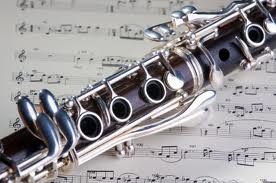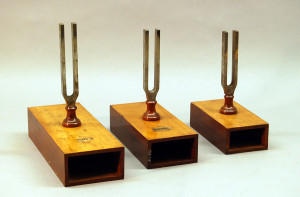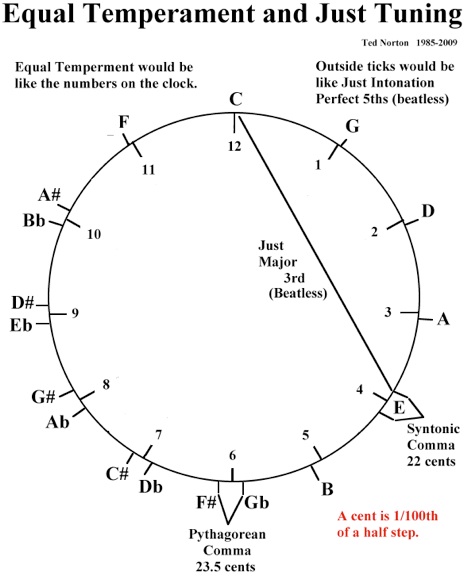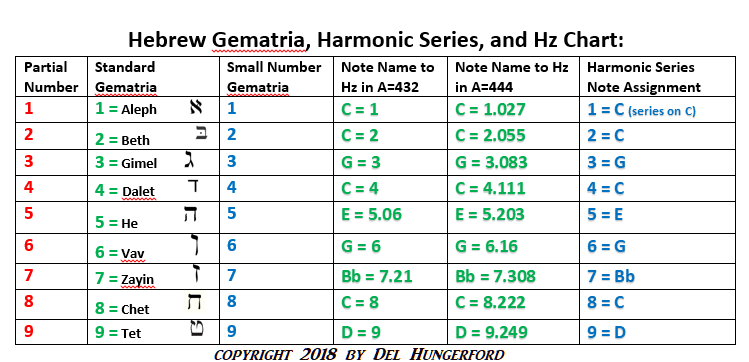In order to understand the process of assigning a frequency to each Hebrew letter, it’s important to take an overview look at musical harmonics, tuning principles, concert pitch, and temperament. A frequency will only stay at an exact Hz under certain circumstances. We have the expectation that there are absolutes, even in believing pitches will stay at a certain frequency. The only way that’s possible is via a tone generator or a device that creates an electronic sound, such as a computer or keyboard instrument. Things that are living, moving, and/or breathing tend to function out of non-absolutes. With that basic understanding, we head forward.
Let’s take a walk down tuning, temperament, and concert pitch lane…
Tuning
 Musical notes change character and tuning based on the context of how and when they’re used. As a clarinetist, I can hold a “G” in a rehearsal under varying chords. When that “G” is the 5th of a chord, it’s super easy to tune. But, the moment the chord changes and that same “G” becomes the 3rd of the chord, I have to make adjustments to bring it down so I’m not sharp. It’s the same note but because the context changes, the frequency (Hz) must also change in order for the note to be in tune. Tuning issues make up more than half of the problems musicians face on a daily basis.
Musical notes change character and tuning based on the context of how and when they’re used. As a clarinetist, I can hold a “G” in a rehearsal under varying chords. When that “G” is the 5th of a chord, it’s super easy to tune. But, the moment the chord changes and that same “G” becomes the 3rd of the chord, I have to make adjustments to bring it down so I’m not sharp. It’s the same note but because the context changes, the frequency (Hz) must also change in order for the note to be in tune. Tuning issues make up more than half of the problems musicians face on a daily basis.
Tuning is all about intervals and how they relate to one another. For example, a Major 3rd on a modern piano is quite sharp. In Pythagorean tuning, it’s even sharper. That’s one reason early musicians simply left it out and never used it! Wind instruments, string players, and singers can adjust, bringing notes in tune as needed. Only “fixed” pitch instruments (piano and fretted instruments) can’t change from equal temperament. This is one reason other instrumentalists have to adjust to the equal temperament of a piano differently than they would when playing with an orchestra or band. I honestly never thought about why that is until this project. When playing with a fixed pitch instrument (keyboards), the non-fixed instruments have to adjust. So, it makes sense that tuning in a band or orchestra can be tough because everyone has the capability to adjust pitches! Enter… mad conductor because the clarinet section can’t figure out how to tune the throat tones. Oh my…
To add confusion to the matter, temperature and humidity changes also affect tuning. One day you’ll be sharp and the next day, it’s a struggle getting up to pitch. In other words, playing in equal temperament isn’t really a thing unless you’re a keyboard or fretted instrument player.
Synopsis – holding a specific Hz for any length of time is nearly impossible unless you’re a tone generator or keyboard player.
Concert Pitch and Temperament:
 Let’s compare the same note in different temperaments. Our example is a “Gb/F#” that resonates at 729 Hz in the A=432 concert pitch using Pythagorean temperament. In just intonation, still in the A=432 concert pitch, it’s closer to 720 Hz. In equal temperament, the pitch resonates at 726 Hz. They are all the same note but resonate at a slightly differing Hz because they’re in different temperaments even though the concert pitch remains A=432.
Let’s compare the same note in different temperaments. Our example is a “Gb/F#” that resonates at 729 Hz in the A=432 concert pitch using Pythagorean temperament. In just intonation, still in the A=432 concert pitch, it’s closer to 720 Hz. In equal temperament, the pitch resonates at 726 Hz. They are all the same note but resonate at a slightly differing Hz because they’re in different temperaments even though the concert pitch remains A=432.
Now, let’s change the concert pitch so the “A” above middle “C” is tuned to A=444. You’ll notice that all the numbers are now higher. In Pythagorean temperament, that F# in the A=444 concert pitch resonates at 749 Hz. In equal temperament, it’s 746 Hz. These two F#’s are a 1/4 step higher than it’s counter part in the A=432 concert pitch. Temperament is what determines Hz within a concert pitch. This is very important to keep in mind when looking at frequency charts.
Concert pitch sets the tuning of ALL notes. Temperament adjusts the distance between notes. A temperament (just, equal, Pythagorean, etc.) must be chosen prior to setting the concert pitch. Fretted instruments, and standard pianos can’t change temperament. Wind instruments can make small changes in temperament and minimal adjustments in concert pitch. Strings and some electronic keyboards have a wider range of choices. Fretted instruments can play in a variety of concert pitches but only in equal temperament. There is nothing evil about equal temperament. It came out of necessity so that instruments could play in all major/minor keys in compositions that were more complicated (1800’s).
The image below shows the difference between equal temperament (inside ticks) and just intonation (outside ticks). Notice that sharps and flats were originally different notes (before equal temperament).

What’s the Big Deal?
Most listeners can’t feel or hear a difference from A=440 and A=444 concert pitch because they are nearly identical. Musical instruments (other than electric keyboards) never stay at A=440 anyway. As they warm up, some tend to play sharp while others go flat. To stay in equal temperament or within the A=440 concert pitch is difficult to do because natural forces (weather, humidity, etc.) affect tuning. Basically, by the time the song is over, an ensemble is no longer in A=440. The more trained the musicians are, the better chance they have of staying closer to the desired pitch.
I went to a competition in France where the pianos were tuned to A=442. I struggled with keeping the pitch down using a clarinet tuned to A=440. When I recorded the album “528 Creative DNA,” I played clarinet on the song Regeneration. This album was recorded in the A=444 concert pitch. I had to make sure my clarinet was really warm when I started. By the end, I was playing sharp and had to use “shading” fingerings to bring the pitch back down! Anyone (other than a keyboardist) that can stay in A=440 during a performance should get five gold stars. Bottom line, all the hype about A=440 is exactly that… hype.
Synopsis – Concert pitch and temperament work together in determining a set list/chart of frequencies. Only tone generators can produce a steady pitch that never changes because it lacks harmonics and is machine generated. Therefore, the whole big fuss about specific concert pitches and temperaments (A=432 vs A=440 vs A=444) being better than others really holds no weight because it’s nearly impossible to keep a pitch from changing during a performance.
Concert Pitch of the Hebrew Letters
 I didn’t go looking to make things fit into a specific concert pitch. I let the research take me down the rabbit trails as they appeared before me. I realized that the frequencies of the Hebrew letters nearly line up with the A=432 concert pitch. Even though I saw this early on, my expectations of a perfect match stumped me. Now, if you paid attention to what I said above, frequencies change depending on which temperament is used. And, it’s possible to temper any pitch to get a slightly different result. I hadn’t taken that into consideration during my initial “seek-and-maybe-find” expedition.
I didn’t go looking to make things fit into a specific concert pitch. I let the research take me down the rabbit trails as they appeared before me. I realized that the frequencies of the Hebrew letters nearly line up with the A=432 concert pitch. Even though I saw this early on, my expectations of a perfect match stumped me. Now, if you paid attention to what I said above, frequencies change depending on which temperament is used. And, it’s possible to temper any pitch to get a slightly different result. I hadn’t taken that into consideration during my initial “seek-and-maybe-find” expedition.
For those who purchase the audio teaching and frequency chart of the Hebrew letters, you’ll notice some small differences between Pythagorean temperament Hz frequencies and a few corresponding Hebrew letter frequencies. I only list one temperament (Pythagorean) on my chart. Other temperaments will show differences in some numbers. So, don’t get hung up on seeing small frequency discrepancies. This next image is of the first 9 Hebrew letters with two forms of gematria, the partial number (harmonic series), assigned pitch, and the A=432 and A=444 concert pitches as a comparison. NOTE: When the numbers are small (1 as compared to 100), a difference of .02 Hz is nearly 1/4 step higher in pitch. In other words, none of the A=444 pitches are the same as those in A=432. The concert pitch of A=444 puts all these notes halfway up to the next note. (The rest of this chart is available with the audio teaching mentioned at the beginning of this paragraph.)

Tuning between notes (tempering) affects the exact frequency. I gave an example earlier of adjusting to the pianos in France. I “tempered” pitches so that I was in tune with the chord. Therefore, I wasn’t playing in equal temperament. There’s no way to stay at an exact frequency unless you’re a tone generator, as I mentioned above. Most of us aren’t tone generators so it’s impossible to keep the same note at a consistent Hz when performing. It’s important to note… when changing temperament, some frequencies will also change even within the same concert pitch.
Intent also weighs heavily in the tonal recipe. Whatever concert pitch a performer chooses is only one ingredient in the recipe. To have a nice “meal” of music, one needs to consider all factors. Frequencies can be used for good or bad. Intent is what makes that determination so it would seem that even if it’s proposed that a concert pitch is harmful, the intent of love can override the harm. For more information on intent, CLICK HERE to read my blog post about it.
I encourage people not to get stuck on the differences in concert pitch saying one is better than the other. For those who propose that A=444 is the divine concert pitch and tuning system to use, I’ve found no evidence of that yet. What I can say is that the musical frequencies of the Hebrew aleph-bet are closer to the A=432 concert pitch than any other.
Conclusion
 Tuning intervals, concert pitch, and temperament all play a part in how nature works in music. As I researched the frequencies of the Hebrew letters, I had to keep these factors in mind. Why? In internet land, there are so many weird and whacky claims and conspiracy theories behind concert pitch and harmful frequencies, along with historical inaccuracies, that I found it challenging at times to wade through the muck. Intent is a heavy weight and will always influence how music is perceived by the listener. That being said, there are certain frequencies that have specific purposes. That’s discussed in other places on this website. Feel free to check out the blog posts for more of that fun reading.
Tuning intervals, concert pitch, and temperament all play a part in how nature works in music. As I researched the frequencies of the Hebrew letters, I had to keep these factors in mind. Why? In internet land, there are so many weird and whacky claims and conspiracy theories behind concert pitch and harmful frequencies, along with historical inaccuracies, that I found it challenging at times to wade through the muck. Intent is a heavy weight and will always influence how music is perceived by the listener. That being said, there are certain frequencies that have specific purposes. That’s discussed in other places on this website. Feel free to check out the blog posts for more of that fun reading.
In this article, I hope that I presented readers with a better understanding that there are no absolutes when it comes to tuning, concert pitch and temperament. That also plays into how to interpret and use the frequencies of the Hebrew letters. Yes, these letters are based on the harmonic series and center around the A=432 concert pitch. But, even in that, there are choices that performers can make in how to adjust those pitches as needed/desired. What appears as an absolute still has possibilities. It’s important to understand that in a creative process.
Del
© Del Hungerford, 2018
[mailerlite_form form_id=2]


[…] information on how musical harmonics plays into this scenario, CLICK HERE to read that article. Tuning is another piece that must be considered. Healing Frequencies Music is a website where we explore […]
[…] cell counts was interesting but not surprising. If you’ve read my most recent article on Concert pitch and the Hebrew letters, I explain how it’s nearly impossible to stay within one concert pitch. In my mind, intent […]